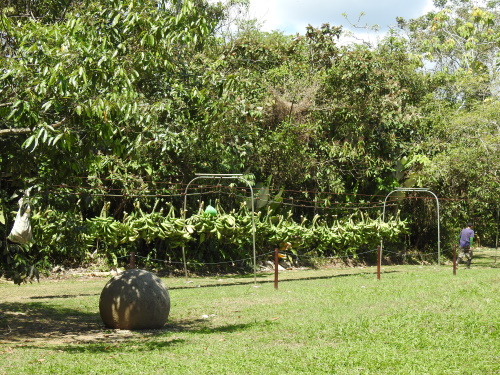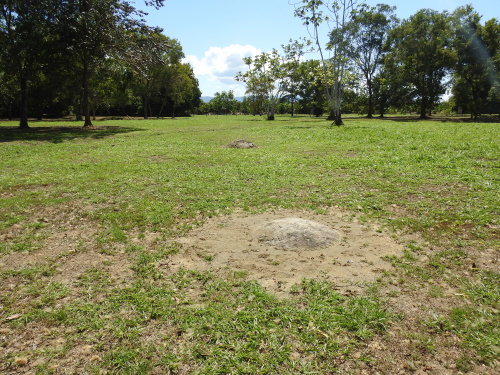Blog WHS Visits
WHS #743: Stone Spheres
This is a kind of WHS visit that I always especially look forward to: remnants of an ancient culture. The Stone Spheres of the Diquís are mysterious stone balls, created by a Precolumbian Costa Rican civilization. With the help of Esteban I tried to get access to a second location in addition to the main site (Finca 6), but although I applied a month before it was not granted (the other 3 locations are not equipped to handle visitors during Covid times was the explanation). So I just focused on Finca 6, which lies in an area dominated by banana and palm oil plantations. The road there is signposted by a simple “Museum” sign.
The pre-trip efforts at least resulted in giving me free access (not something that I was after) and a guided tour of the museum and the archaeological site. The museum is small, but shows that in addition to stone spheres, the Diquís also left ceramics and stone figurines.
Then we walked onto the site of the excavations. A trail takes you past the main points of what was once a settlement of about 500 inhabitants. It only takes a few minutes for the first sphere to come into sight. Before we could get closer, something happened that is also typical for this place: a load of bananas passed by! The land in this area has been used by the United Fruit Company (now: Chiquita) as a banana plantation since the 1930s. They use a system of overhead lines across the terrain along which the heavy bunches of bananas are pulled by a man. You can hear them coming from afar, it is as if you have to cross a tramway railtrack.
The settlement was conveniently built near a river and it is crossed by several streams. The Diquís took stones from the river to build their village, although the larger stones for the spheres were taken from further away.
Most of the stone spheres found here at Finca 6 have been preserved because they were buried for centuries under thick layers of sediment. They were up to 1.5m deep in the ground. Some specimens have been damaged by the sun and also by agricultural machinery from the banana plantation. That is why most of them have now been reburied and only their tops show above the grass line.
The first stone spheres that we see belonged to the homes of high-ranking residents. The houses were built on a platform, with a ramp made of river stones and then a stone sphere each on either side of the entrance. The spheres were larger or smaller, depending on the prestige of the resident. Spheres were also placed on public grounds. These probably had a role in ceremonies. There are three in a row in the center of the Finca 6 site which are said to have astronomical connotations.
At the end of the route there are two more groups of spheres that have been brought here from other places in the area. They had simply been in people's homes or in their gardens for a long time. Here they are now protected, although they suffer from the sun and varying temperatures. You can clearly see how they were made: cut from a large stone and then sanded.
In the afternoon I tried to find two of the other locations, although I knew they would be closed. Batambal lies almost next to the main road 34 between Uvita and Palmar Norte. There is a small signpost coming from the south. About 1.5 km of dirt road follows, through a neighbourhood where the inhabitants looked at me suspicuously. It ends at a field and a gate. The second location was Grijalba-2: I got close to that one too, but ended up at a farm. There are 3 dirt roads next to each other where the marker is on the map. Here are no signposts. The ‘best’ location apart from Finca 6 seems to be El Silencio, as there the biggest sphere lies buried.
Els - 4 April 2021
Comments
Esteban Cervantes Jiménez (vantcj1) 5 April 2021
Well, it seems that you enjoyed the visit, even when we couldn't get the approval for the visit to other sites. A pleasure to have been of help to get the collaboration of the site manager and the presence of the site educator, so that you obtained the best perspective of this particular site and the overall sites' OUV. Though the initial colonization of Osa municipality by the banana company (in the 1930s and 1940s) was extremely detrimental to the preservation of the original sites and so their original alignments, it is also an important component of heritage there, as your review shows and as many buildings at Palmar Sur attest.


